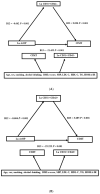The Association between 4-Tertiary-Octylphenol, Apoptotic Microparticles, and Carotid Intima-Media Thickness in a Young Taiwanese Population
- PMID: 37755767
- PMCID: PMC10537624
- DOI: 10.3390/toxics11090757
The Association between 4-Tertiary-Octylphenol, Apoptotic Microparticles, and Carotid Intima-Media Thickness in a Young Taiwanese Population
Abstract
As one of the most common alkylphenols, 4-tertiary-octylphenol (4-tOP) is commonly used in many consumer products. Our previous epidemiological study revealed a negative correlation between serum 4-tOP levels and carotid intima-media thickness (CIMT), which serves as a biomarker of arteriosclerosis. We aimed to explore the role of apoptotic microparticles, markers of vascular endothelial cell function, in the 4-tOP and CIMT connection. To investigate this, we enrolled 886 Taiwanese adolescents and young adults (aged 12-30 years) and examined the relationships among serum 4-tOP levels, apoptotic microparticles (CD31+/CD42a-, CD31+/CD42a+), and CIMT. Our results showed negative associations among serum 4-tOP levels, both apoptotic microparticles, and CIMT in multiple linear regression analysis. The odds ratios for CIMT (≥75th percentile) and the natural logarithm of 4-tOP were highest when both CD31+/CD42a- and CD31+/CD42a+ were greater than the 50th percentile. Conversely, the odds ratios were lowest when both CD31+/CD42a- and CD31+/CD42a+ were less than the 50th percentile. In the structural equation model, we demonstrated that serum 4-tOP levels were negatively correlated with CIMT and indirectly and negatively correlated with CIMT through both apoptotic microparticles. In conclusion, our study reported the inverse association between 4-tOP apoptotic microparticles and CIMT in a young Taiwanese population. Further experimental studies are needed to clarify these associations.
Keywords: 4-tertiary-octylphenol (4-tOP); CD31+/CD42a+; CD31+/CD42a−; apoptotic microparticles; common carotid artery intima-media thickness (CIMT).
Conflict of interest statement
The authors declare no conflict of interest.
Figures
Similar articles
-
The association of carotid intima-media thickness with serum Level of perfluorinated chemicals and endothelium-platelet microparticles in adolescents and young adults.Environ Int. 2016 Sep;94:292-299. doi: 10.1016/j.envint.2016.06.004. Epub 2016 Jun 9. Environ Int. 2016. PMID: 27288966
-
Apoptotic microparticles mediate the association between bisphenol A and subclinical atherosclerosis in a young population: A population-based study.Ecotoxicol Environ Saf. 2021 Nov;224:112663. doi: 10.1016/j.ecoenv.2021.112663. Epub 2021 Aug 18. Ecotoxicol Environ Saf. 2021. PMID: 34418852
-
The Association among Urinary Lead and Cadmium, Serum Adiponectin, and Serum Apoptotic Microparticles in a Young Taiwanese Population.Nutrients. 2023 Oct 25;15(21):4528. doi: 10.3390/nu15214528. Nutrients. 2023. PMID: 37960181 Free PMC article.
-
Global DNA methylation mediates the association between urine mono-2-ethylhexyl phthalate and serum apoptotic microparticles in a young Taiwanese population.Sci Total Environ. 2022 Feb 20;808:152054. doi: 10.1016/j.scitotenv.2021.152054. Epub 2021 Dec 1. Sci Total Environ. 2022. PMID: 34863772
-
Meta-analysis of the correlation between serum uric acid level and carotid intima-media thickness.PLoS One. 2021 Feb 11;16(2):e0246416. doi: 10.1371/journal.pone.0246416. eCollection 2021. PLoS One. 2021. PMID: 33571245 Free PMC article.
References
-
- Hou Y., Li S., Xia L., Yang Q., Zhang L., Zhang X., Liu H., Huo R., Cao G., Huang C., et al. Associations of urinary phenolic environmental estrogens exposure with blood glucose levels and gestational diabetes mellitus in Chinese pregnant women. Sci. Total Environ. 2021;754:142085. doi: 10.1016/j.scitotenv.2020.142085. - DOI - PubMed
Grants and funding
LinkOut - more resources
Full Text Sources
Research Materials


